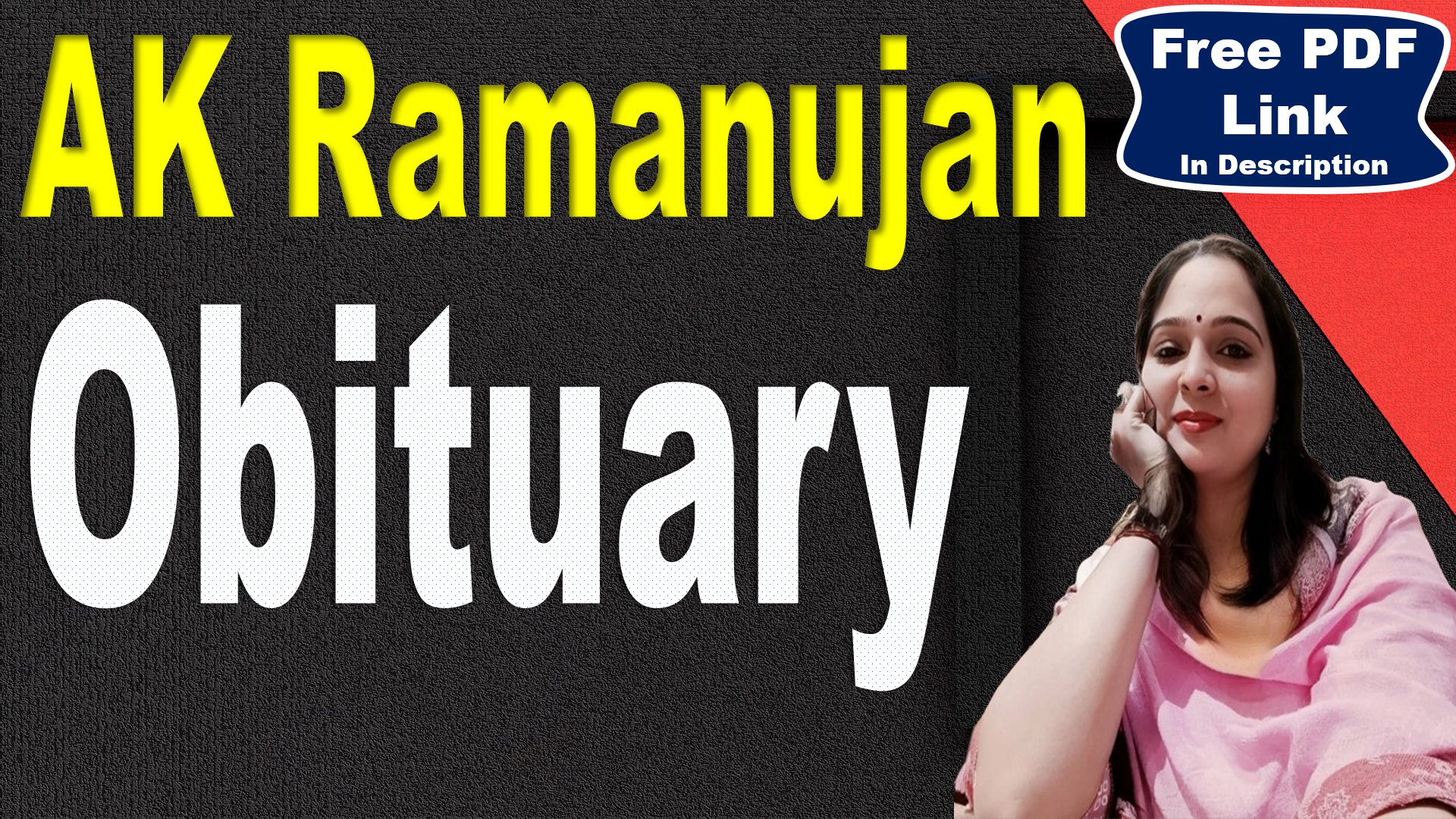Obituary by AK Ramanujan Questions and Answers
Very Short Answer Questions
Who wrote the poem Obituary?
A. K. Ramanujan wrote the poem.
What is the poem Obituary mainly about?
The poem reflects on the death of the poet’s father and its impact.
What did the father leave behind after his death?
The father left dust, debts, daughters, and a bedwetting grandson.
What type of poem is Obituary?
It is a free verse poem.
How did the poet’s father die?
He died of heart failure in a fruit market.
What ritual do the sons perform in the poem?
They pick up the father’s remains and throw them as the priest instructed.
Where did the cremation ritual take place?
It took place facing east, near where three rivers met.
What symbolized the father’s legacy in the poem?
The obituary lines in a newspaper symbolized his legacy.
What does the poet search for in the newspaper cones?
He searches for his father’s obituary lines.
What imagery does the poem use to depict the family house?
The house is depicted as leaning on a bent coconut tree.
What does the “bedwetting grandson” signify in the poem?
It signifies the continuation of life and the father’s influence.
How many lines did the father’s obituary receive?
It received only two lines.
What is significant about the newspaper being sold by the kilo?
It emphasizes the impermanence and trivialization of life’s achievements.
What tone is used throughout the poem?
The tone is reflective and melancholic.
What is one symbol of family responsibility mentioned in the poem?
The sons performing the cremation ritual symbolizes responsibility.
How does the poet describe his mother after the father’s death?
He describes her as “a changed mother.”
What does “no longstanding headstone” imply?
It implies the father’s lack of lasting memorial or legacy.
What literary device is used in “eye coins”?
Symbolism is used, representing the journey to the afterlife.
What does the poet read the newspaper cones for?
For fun and to find traces of his father’s obituary.
What annual tradition is mentioned at the end of the poem?
The poem mentions more than one annual ritual kept after the father’s death.
Short Answer Questions
What significance does the father’s death hold in the poem Obituary?
The father’s death in Obituary serves as a catalyst for exploring themes of memory, family responsibility, and the fleeting nature of legacy. While he leaves behind debts, daughters, and a grandson, his impact is minimal in the broader world, represented by his two-line obituary. The poem emphasizes how personal loss contrasts with society’s indifference, highlighting the quiet grief and ongoing traditions within the family.
How does A. K. Ramanujan use imagery in the poem?
Ramanujan uses vivid imagery to create a sensory-rich portrayal of the father’s life and death. He describes the “dust on a table of papers,” a house leaning on a “bent coconut tree,” and the remnants of the father’s body after cremation. These images ground the poem in reality and evoke emotions related to loss, impermanence, and familial duty.
What does the phrase “no longstanding headstone” symbolize?
The phrase “no longstanding headstone” symbolizes the father’s lack of a permanent or notable legacy. It suggests that his life, despite its struggles and contributions, did not leave a significant mark on the world. This absence emphasizes the theme of how many lives are quickly forgotten, reduced to memories held only by those closest to them.
How does the poet’s relationship with his father influence the poem?
The poet’s relationship with his father is complex and marked by subtle emotions. Although he acknowledges the father’s influence through memories and rituals, there is a sense of detachment when describing the father’s passing and the rituals that follow. This reflects a nuanced mixture of respect, acceptance, and an understanding of the father’s imperfect legacy.
Why does the poet mention reading newspaper cones?
The poet mentions reading newspaper cones to show how his father’s life, once recorded in a brief obituary, has become part of everyday life. This detail highlights the ordinariness of death and how even significant moments become trivialized over time. It reflects the poet’s search for a connection to his father and the blending of personal memory with mundane reality.
What does the “bedwetting grandson” represent in the poem?
The “bedwetting grandson” represents the continuation of the family line and the imperfect legacy the father leaves behind. It introduces a touch of humor and innocence, suggesting that life continues in its ordinary, flawed way even after death. This detail underscores the randomness of life and the small, personal ways the father’s memory persists.
How does the poem reflect the cultural practices surrounding death?
The poem reflects Indian cultural practices through the depiction of the cremation ritual, where the sons handle the father’s remains and follow the priest’s directions. The act of facing east near a confluence of rivers, the use of eye coins, and the annual rituals all highlight traditional beliefs about death and the afterlife, showing how these customs blend with personal grief.
What does the imagery of “dust on a table of papers” suggest?
The imagery of “dust on a table of papers” suggests unfinished business, neglect, and the mundane aspects of life that remain after death. It symbolizes the responsibilities and incomplete tasks the father left behind, creating an image of a life that was not neatly resolved and leaving the family with burdens to manage.
How is irony used in Obituary?
Irony is used to highlight the disparity between the significance of the father’s life to his family and how it is perceived by the outside world. Despite the rituals and memories held by the family, the father receives only two unnoticed lines in a local newspaper, which later becomes wrapping for groceries. This irony underscores the theme of the transient nature of life and remembrance.
What role do the annual rituals play in the poem?
The annual rituals mentioned in the poem symbolize the ongoing connection to the father and the way the family keeps his memory alive. These rituals represent both the weight of tradition and the means by which the family honors his presence, even in a subtle, routine way. It shows how the father’s legacy endures through these practices, despite the lack of public acknowledgment.










